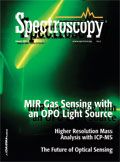IFPAC
Spectroscopy previews the upcoming IFPAC Annual Meeting, to be held January 25–28, 2009, in Baltimore, Maryland.
Spectroscopy previews the upcoming IFPAC Annual Meeting, to be held January 25–28, 2009, in Baltimore, Maryland.
The 23rd International Forum for Process Analytical Technology (IFPAC-09) will be held at the Baltimore Marriott Waterfront Hotel, located within Baltimore's Inner Harbor, from January 25 through January 28, 2009. IFPAC is the leading conference in process analysis and technology, and this will be an exciting forum in which to learn about recent developments in the field of process analytical chemistry, technology, and control applications in many different industries.

In addition to the conference events, attendees can enjoy various shops and harbor restaurants, the Baltimore National Aquarium, the Maryland Science Center, The Peabody Conservatory, and more.
FDA Workshop
On Sunday afternoon, January 25, Lawrence Yu, Steven Kozlowski, and Christine Moore, of the FDA, will present a special workshop entitled Quality by Design in Pharmaceutical Development and Manufacturing: An FDA Update. This in-depth look at the FDA's viewpoint of their Quality Initiative will be presented from the perspective of their three review offices: biotech products, generic drugs, and new drugs. The purpose of this workshop is to discuss implementation progress of Quality by Design (QbD) and process analytical technology within the pharmaceutical and biopharmaceutical industries with the goal of supporting overall operational excellence. The program will end with an interactive roundtable discussion that encourages audience participation and networking among attendees.

Plenary Lecture
The plenary session, Operational Excellence Through Process Understanding and Control ... Facing Today's Challenges, will be chaired by Stephen Jacobs, Duncan Low, and Christine M.V. Moore on Monday morning, January 26.
Symposia, Workshops, and Posters
Daily lectures, workshops, and short courses focusing on the latest developments in process analytical technology will be conducted by leading experts in their respective fields. Topics include separation techniques, Raman spectroscopy, chemical imaging, process control and quality, electrochemical techniques, chemometrics, pharmaceutical design space, PAT for biologics manufacturing, handheld (portable) instrumentation, standards in process analytical chemistry, and future trends.
Exhibits
The three-day exhibit hall will be open from January 26–28, 2009, at the conference. The exhibit floor is considered an integral part of the annual conference, and showcases the new products and services most desired by this specialized audience.
Registration
All-inclusive registration includes three days lodging and meals. For more information and to register online, visit the IFPAC web page at www.ifpac.com.
IFPAC Committee
253 Commerce Drive, Suite 103
P.O. Box 7100 Grayslake, IL 60030
Phone: (847) 543-6800;
Fax: (847) 548-1811
Email: info@ifpacnet.org

Newsletter
Get essential updates on the latest spectroscopy technologies, regulatory standards, and best practices—subscribe today to Spectroscopy.
The Rising Role of Near-Infrared Spectroscopy in Biofuel Innovation
July 25th 2025A new bibliometric study published in Infrared Physics & Technology highlights the growing global impact of near-infrared (NIR) spectroscopy in biofuel research, revealing key trends, contributors, and future directions for advancing sustainable energy solutions.
Best of the Week: The Emerging Leader in Molecular Spectroscopy, Big Pharma’s Manufacturing Shift
July 25th 2025Top articles published this week include a feature article about big pharma’s investments in U.S.-based manufacturing, an article about the 2025 Emerging Leader in Molecular Spectroscopy Lingyan Shi, and some news items detailing the winners of the Coblentz Society’s student awards.